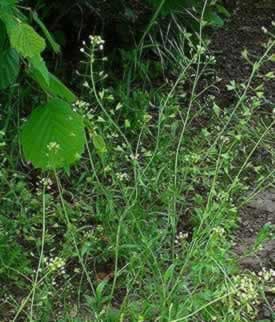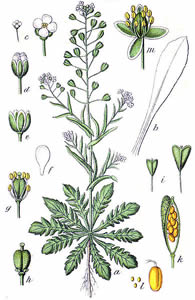Shepherds Purse Capsella bursa-pastoris
- Common Names
- Shepherd's Purse , Pickpurse, Casewort
- Botanical Name
- Capsella bursa-pastoris
- Family
- BRASSICACEAE
Medicinal Uses & Benefits of Shepherd's Purse
![]() How to Use|
Side Effects |
Plant & Garden|
How to Use|
Side Effects |
Plant & Garden|
- Medicinal Uses: * Cardiovascular
* Cuts & Wounds
* Menorrhagia
- Properties: * Antiscorbutic * Astringent * Diuretic * Emmenagogue * Febrifuge * Hypotensive * Refrigerant * Styptic
- Parts Used: whole herb
- Constituents: choline, acetylcholine and tyramine, saponins, mustard oil, flavonoids
How to Use: Shepherds Purse
Shepherd's purse contains a protein that acts in the same way in the body as the hormone oxytocin, constricting the smooth muscles that support and surround blood vessels, especially those in the uterus. Other chemicals in the herb may accelerate clotting. Still other compounds in the herb help the uterus contact, explaining the long-time use of the herb to help the womb return to normal size after childbirth. 1
Preparation Methods & Dosage :Most often taken as a tea.
Shepherds Purse Remedies
Traditional Chinese Medicine
 Shepherd's purse is used in traditional Chinese medicine formulas for blurred vision, and spots before the eyes.
Shepherd's purse is used in traditional Chinese medicine formulas for blurred vision, and spots before the eyes.
Shepherds Purse Side Effects: Not recommended during pregnancy, the herb can cause uterine contractions. Not for those with liver or kidney disease.
Plant Description
- Flowers: Small, white, in a long, loose raceme, followed by triangular and notched (somewhat heart-shaped) pods, the valves boat-shaped and keeled. Sepals and petals 4; stamens 6; 1 pistil.
- Stem: 6 to 18 in. high, from a deep root.
- Leaves: Forming a rosette at base, 2 to 5 in. long, more or less cut (pinnatifid), a few pointed, arrow-shaped leaves also scattered along stem and partly clasping it.
- Flowering Season: Almost throughout the year.
- Preferred Habitat: Fields, roadsides, waste places
- Distribution: Over nearly all parts of the earth
From Europe this little low plant found its way, to become the commonest of our weeds, so completing its march around the globe. At a glance one knows it to be related to the alyssum and candytuft of our gardens, albeit a poor relation in spite of its vaunted purses—the tiny, heart-shaped seed-pods that so rapidly succeed the flowers. What is the secret of its successful march over the face of the earth? Like the equally triumphant chickweed, it is easily satisfied with unoccupied waste land, it avoids the fiercest competition for insect trade by prolonging its season of bloom far beyond that of any na�tive flower, for there is not a month in the year when one may not find it even in New England in sheltered places. Netje Blanchan. Wild Flowers worth Knowing (1917)













